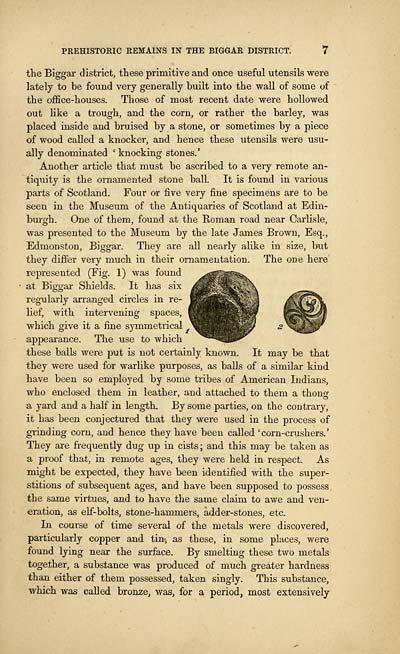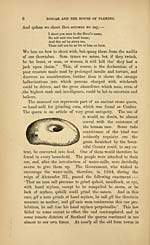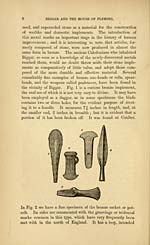Biggar and the House of Fleming
(25) Page 7
Download files
Complete book:
Individual page:
Thumbnail gallery: Grid view | List view

PREHISTORIC REMAINS IN THE BIGGAR DISTRICT. 7
the Biggar district, these primitive and once useful utensils were
lately to be found very generally built into the wall of some of
the office-houses. Those of most recent date were hollowed
out like a trough, and the corn, or rather the barley, was
placed inside and bruised by a stone, or sometimes by a piece
of wood called a knocker, and hence these utensils were usu-
ally denominated ' knocking stones.'
Another article that must he ascribed to a very remote an-
tiquity is the ornamented stone ball It is found in various
parts of Scotland. Four or five very fine specimens are to be
seen in the Museum of the Antiquaries of Scotland at Edin-
burgh. One of them, found at the Roman road near Carlisle,
was presented to the Museum by the late James Brown, Esq.,
Edmonston, Biggar. They are all nearly alike in size, but
they differ very much in their ornamentation. The one here
represented (Fig. 1) was found
at Biggar Shields. It has six
regularly arranged circles in re-
lief, with intervening spaces,
which give it a fine symmetrical ^
appearance. The use to which
these bails were put is not certainly known. It may be that
they were used for warlike purposes, as balls of a similar kind
have been so employed by some tribes of American Indians,
who enclosed them in leather, and attached to them a thonff
a yard and a half in length. By some parties, on the contrary,
it has been conjectured that they were used in the process of
grinding corn, and hence they have been called 'corn-crushers.'
They are frequently dug up in cists ; and this may be taken as
a proof that, in remote ages, they were held in respect. As
might be expected, they have been identified with the super-
stitions of subsequent ages, and have been supposed to possess
the same virtues, and to have the same claim to awe and ven-
eration, as elf-bolts, stone-hammers, adder-stones, etc.
In course of time several of the metals were discovered,
particularly copper and tin-, as these, in some places, were
found lying near the surface. By smelting these two metals
together, a substance was produced of much greater hardness
than either of them possessed, taken singly. This substance,
which was called bronze, was, for a period, most extensively
the Biggar district, these primitive and once useful utensils were
lately to be found very generally built into the wall of some of
the office-houses. Those of most recent date were hollowed
out like a trough, and the corn, or rather the barley, was
placed inside and bruised by a stone, or sometimes by a piece
of wood called a knocker, and hence these utensils were usu-
ally denominated ' knocking stones.'
Another article that must he ascribed to a very remote an-
tiquity is the ornamented stone ball It is found in various
parts of Scotland. Four or five very fine specimens are to be
seen in the Museum of the Antiquaries of Scotland at Edin-
burgh. One of them, found at the Roman road near Carlisle,
was presented to the Museum by the late James Brown, Esq.,
Edmonston, Biggar. They are all nearly alike in size, but
they differ very much in their ornamentation. The one here
represented (Fig. 1) was found
at Biggar Shields. It has six
regularly arranged circles in re-
lief, with intervening spaces,
which give it a fine symmetrical ^
appearance. The use to which
these bails were put is not certainly known. It may be that
they were used for warlike purposes, as balls of a similar kind
have been so employed by some tribes of American Indians,
who enclosed them in leather, and attached to them a thonff
a yard and a half in length. By some parties, on the contrary,
it has been conjectured that they were used in the process of
grinding corn, and hence they have been called 'corn-crushers.'
They are frequently dug up in cists ; and this may be taken as
a proof that, in remote ages, they were held in respect. As
might be expected, they have been identified with the super-
stitions of subsequent ages, and have been supposed to possess
the same virtues, and to have the same claim to awe and ven-
eration, as elf-bolts, stone-hammers, adder-stones, etc.
In course of time several of the metals were discovered,
particularly copper and tin-, as these, in some places, were
found lying near the surface. By smelting these two metals
together, a substance was produced of much greater hardness
than either of them possessed, taken singly. This substance,
which was called bronze, was, for a period, most extensively
Set display mode to:
![]() Universal Viewer |
Universal Viewer | ![]() Mirador |
Large image | Transcription
Mirador |
Large image | Transcription
Images and transcriptions on this page, including medium image downloads, may be used under the Creative Commons Attribution 4.0 International Licence unless otherwise stated. ![]()
| Histories of Scottish families > Biggar and the House of Fleming > (25) Page 7 |
|---|
| Permanent URL | https://digital.nls.uk/94839582 |
|---|
| Description | A selection of almost 400 printed items relating to the history of Scottish families, mostly dating from the 19th and early 20th centuries. Includes memoirs, genealogies and clan histories, with a few produced by emigrant families. The earliest family history goes back to AD 916. |
|---|

